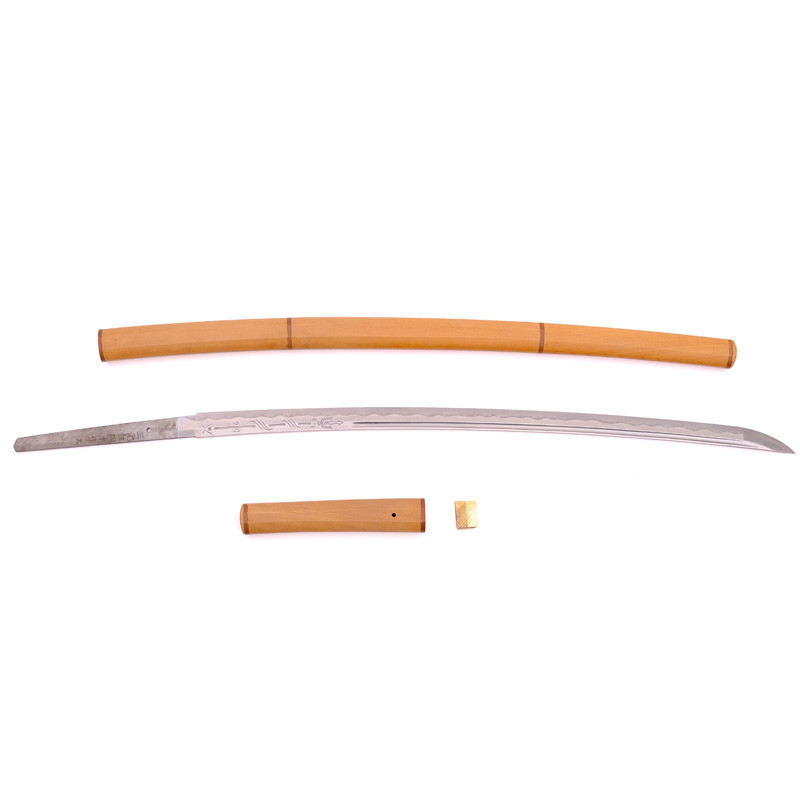| Horimono |
Omote 表:
- Hatahoko 幡, a spear with banner, an esoteric Buddhist symbol representing the sword of Bishamon 毘沙門.
- Rendaï 蓮 台, Symbol representing a lotus flower, the seat of Buddha, symbol of purity and enlightenment.
Ura 裏:
- Tsume 爪, representing dragon claws or the end of a Vajra, Buddhist ritual handle that drives away demons and evil spirits.
- Gomabashi 護摩箸, pairs of chopsticks used during a Buddhist fire ritual to ask for the blessing of Acala (Fudo Myo).
|
Study
&
Team Review |
Komiya Kunitada 小宮国忠, of civil name Komiya Yokimitsu 小宮陽氣光, was born in 1954. He is a blacksmith from the city of Omuta 大牟田, in the prefecture of Fukuoka 福岡 in Kyushu.
One of the special features of the city of Omuta is the operation of the Miike coal mines, which operated from 1860 to 1997. These mines, called Mitsui Miike Tankō 三井三池炭鉱, were the largest coal mines in Japan. They have been exploited since the 15th century under the control of the Tachibana clan. They are now part of the Meiji industrial revolution and are listed as World Heritage.
The Komiya family is a line of blacksmiths dating back to the Bakumatsu (1853 - 1868).
The grandfather, Komiya Shiro Kunimitsu 小宮四郎国光, with whom Komiya Kunitada began the study of the forge in 1972, was an outstanding forger during the Showa period, ranked Saijo Owazamono for the exceptional quality of his sabres.
The father Komiya Kuniharu 小宮国治 (1929-2020) began the study of forging with Shiro Kunimitsu in 1941. In 1979, he was selected for competitions (Nyusen), and later won an effort prize (Doryoku). His works are inspired by the blacksmith Miike Tenta Mitsuyo 三池典太光世 of the Heian period. There still exist today 3 historical blades of Mitsuyo that have crossed the centuries passing from hands to hands in families of great lords.
Komiya Kunitada’s two brothers are Komiya Yasukimitsu 安気光 (called Yasumitsu 安光) and Komiya Hayakimitsu 早陽光 (called Kunimitsu 国光).
Yasumitsu 安光 was born in 1956, he began learning to forge with his grandfather Kunimitsu in 1973. He was selected for competitions (Nyusen) from 1992 and won the effort prize (Doryoku) in 2016. His work is inspired by the works of the tradition of Soshu Den, and in particular Kiyomaro 清麿.
Kunimitsu 国光 was born in 1959, he began learning the forge with his grandfather Kunimitsu in 1978. He was selected for competitions (Nyusen) from 1992 and won the Kunzan prize in 2018, then the effort prize (Doryoku) and award of excellence (Yushu). His work is inspired by the works of the Bizen Den tradition, and in particular the Fukuoka Ichimonji 福岡一文字 school.
Finally, Komiya Kunitada 小宮国忠 was born in 1954 and began learning to forge with his grandfather Shiro Kunimitsu in 1972. He was selected for competitions (Nyusen) from 1992. His work is inspired by the works of the tradition of Soshu Den, and in particular Kotetsu 虎 徹.
The Komiya family originated from Muto Shinano No Kami Hisahiro 武藤信濃守藤原久廣, an official forger of the Tachibana family at Yanagawa estate in Chikugo 筑後 during the Edo period.
The 4th generation of the Muto school 武藤, is represented by Komiya Shiro Kunimitsu 小宮四郎国光, grandfather of Komiya Kunitada. Anecdotally, in a sword test before the Second World War, in 1939, Shiro Kunimitsu won the championship, which earned him the nickname of "Current Kotetsu" 今虎徹 (Kotetsu was one of the greatest Japanese blacksmith, at the beginning of the Edo era). His sword was one of three presented to the emperor that year.
The Komiya lineage has become highly renowned for the quality of their cutting edge.
Another fact, Shiro Kunimitsu is also famous in his work of the blade called «Tenjin Tsukihoshi Maru». During a long period of drought, in order to ask for the rains of the gods, this blade was made as an offering. This request was heard and it began to rain on the first day of the forge and again on its end.
One of Shiro Kunimitsu’s students, So Tsutomu, became Mukansa blacksmith in 1990, the best Japanese blacksmith. The blade presented here is very similar to a realization of So Tsutomu, appearing on page 136 of the book «Modern Japanese Swords and Swordsmiths» by Kapp and Yoshihara.
Here is a beautiful blade in the spirit of the Nambokucho era (1333-1392) wide mihaba, little fumbari, fine kasane and long kissaki. Its 6.7 mm kasane allows it to have a nice balance given its length of 81cm.
The wide nioi-deki hamon allows to have a very high cutting edge!
|



















Share your opinion
error Your review appreciation cannot be sent
feedback Report comment
check_circle Report sent
error Your report cannot be sent